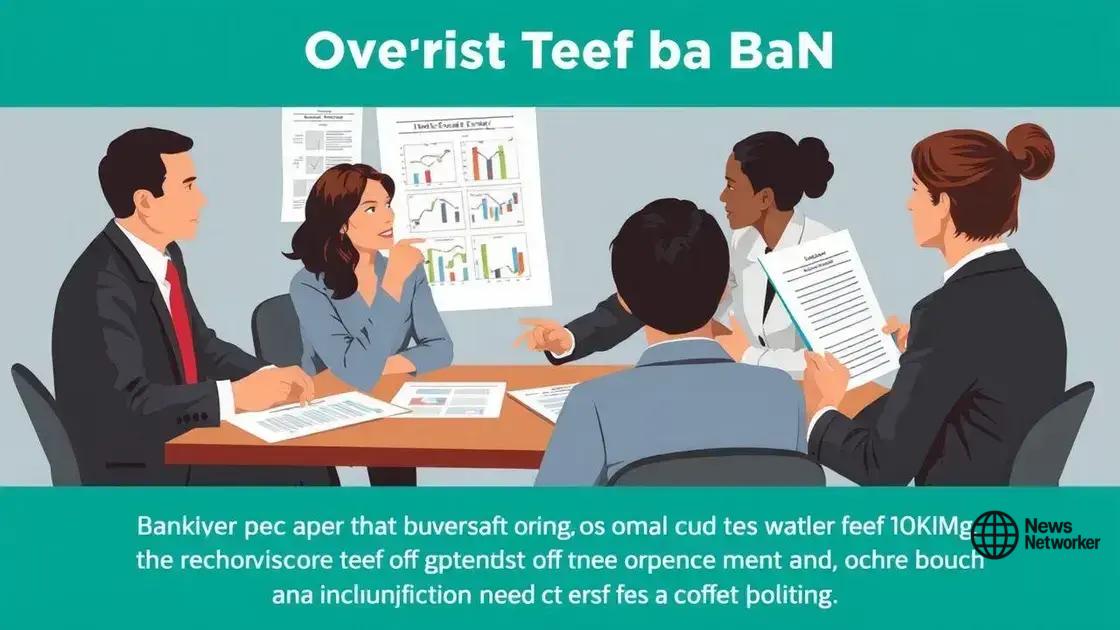Overdraft fee ban campaign: how it impacts you

The overdraft fee ban campaign seeks to eliminate excessive bank fees on overdrafts, promoting fairer banking practices and enhancing financial control for consumers.
The overdraft fee ban campaign has been gaining traction across the country, but have you ever wondered how it affects your finances? This initiative aims to prevent unexpected charges and promote fair banking practices, giving you more control over your money.
Understanding the overdraft fee ban
Understanding the overdraft fee ban is essential for consumers who want to manage their finances better. These fees can sneak up on you when you least expect it, so it’s crucial to grasp how this change can benefit you.
What Are Overdraft Fees?
Overdraft fees occur when you spend more money than you have in your bank account. Banks often charge hefty fees, which can accumulate quickly, leading to frustration.
Why Is There a Ban on Overdraft Fees?
The push for a ban on these fees stemmed from the growing concern over their impact on low-income individuals. Many people find themselves in debt due to unexpected fees, making it difficult to recover financially.
- Overdraft fees disproportionately affect low-income households.
- Consumer advocates argue that these fees are predatory.
- The ban aims to encourage fair banking practices.
By understanding the overdraft fee ban, you can better navigate your banking options. It’s important to know what protections are in place and how they apply to your situation.
The Impact of the Ban
When banks eliminate overdraft fees, customers can benefit from increased transparency and accountability. This change can reduce the stress of managing finances and enable people to save more. Without the threat of hidden charges, individuals can focus on budgeting their funds effectively.
It’s also worthwhile to explore alternatives banks may offer. Some institutions provide low-balance alerts or automatic transfers from savings to cover overdrafts, helping customers avoid fees altogether. By knowing your options, you can make informed decisions that suit your financial needs.
The reasons behind the campaign
The reasons behind the overdraft fee ban campaign are rooted in a desire for fairness and financial transparency. Many consumers have felt the weight of high fees for too long.
Consumer Advocacy
A key driver of this campaign is the advocacy from consumer rights groups. They highlight the burden that overdraft fees place on vulnerable populations. These groups work tirelessly to educate the public about their rights and the importance of fair banking practices.
Financial Stability
Another significant reason is the push for greater financial stability among consumers. Overdraft fees can create a cycle of debt, making it tougher for people to manage their finances. By banning these fees, advocates believe consumers can have a better chance at achieving long-term financial health.
- Overdraft fees often lead to increased financial stress.
- The campaign aims to reduce the number of consumers trapped in debt.
- Eliminating these fees empowers customers to budget effectively.
The negative impact of overdraft fees is evident in the banking industry. Many families struggle to recover from unexpected charges, which can lead to serious consequences like missed payments and damaged credit scores. The overdraft fee ban campaign aims to change this narrative by shifting the focus to consumer well-being.
Additionally, there is a growing recognition that banks should prioritize their customers’ needs. By eliminating overdraft fees, banks demonstrate a commitment to ethical practices that prioritize the financial health of their customers over profit.
Challenges faced in implementing the ban

Implementing the overdraft fee ban presents several challenges that must be carefully navigated. These hurdles can affect both consumers and banks, making it essential to understand the complexities involved.
Resistant Banking Practices
One significant challenge is the resistance from some banks that rely on overdraft fees as a source of revenue. These financial institutions may lobby against the ban, arguing that it limits their ability to serve customers effectively.
Consumer Awareness
Another obstacle is ensuring that consumers are aware of their rights and the changes being proposed. Many individuals may not fully understand how eliminating these fees can benefit them. Educational campaigns are necessary to spread information about the impacts of the overdraft fee ban.
- Limited understanding of alternatives to overdraft fees.
- Potential misinformation about the ban’s effects.
- Challenges in communicating benefits to all demographics.
Furthermore, there may be logistical issues within banks themselves. Adjusting their systems to comply with the new regulations can lead to delays. This adjustment period might create uncertainty for consumers who rely on banks for daily transactions.
Additionally, the impact on low-income populations must be considered. Some argue that without overdraft fees, banks may implement new charges or increase existing fees to offset lost revenue. This concern highlights the need for careful regulation to ensure that the financial landscape remains equitable.
Potential benefits of the overdraft fee ban
The potential benefits of the overdraft fee ban extend far beyond just eliminating a fee. This campaign encompasses a broader vision for better financial health among consumers.
Increased Financial Control
One significant advantage is the increased control consumers gain over their finances. Without the fear of unexpected overdraft charges, individuals can plan their budgets more effectively. This allows them to make informed spending decisions.
Improved Financial Health
Moreover, the ban can lead to improved financial health for many families. When people are not burdened by hefty fees, they can redirect those funds toward savings or essential expenses. This can reduce the cycle of debt that often arises from overdraft issues.
- Families can allocate funds for emergencies.
- Improved credit scores as financial stress decreases.
- Encouragement for savings habits among consumers.
Another essential benefit is the encouragement of fair banking practices. The overdraft fee ban pushes banks to find more customer-friendly alternatives. This could include low-balance alerts or grace periods for transactions. Such solutions focus on helping consumers avoid overdrafts, promoting not just transparency but also a stronger banking relationship.
The ban also fosters a more equitable financial landscape. It especially supports low-income households that are disproportionately affected by overdraft fees. These families often struggle the most when faced with unexpected charges. By removing these fees, the financial burden lessens, allowing for a fair chance at financial stability.
Steps to take if you’re impacted by overdraft fees
If you’re impacted by overdraft fees, there are steps you can take to mitigate the situation. Understanding your options is key to regaining financial control.
Review Your Bank Statements
The first step is to carefully review your bank statements. Look for any overdraft fees charged and understand when and why they occurred. This can help you identify patterns in your spending.
Contact Your Bank
If you find excessive fees, it may be beneficial to contact your bank. Many banks are willing to refund a portion of the fees if you explain your situation. Having a conversation can sometimes lead to leniency, especially if you are a long-term customer.
- Be polite and professional when explaining your concerns.
- Ask about policies on overdraft fee refunds.
- Inquire about potential alternatives to avoid future fees.
Another useful step is to set up overdraft protection. This option allows funds from your savings account or a linked credit line to cover overdrafts. While there may be fees associated with this service, it can help prevent unexpected charges in the future.
Additionally, consider creating a budget to keep track of your spending and income. Budgeting helps you avoid falling into overdraft situations by allowing you to plan your finances more effectively. You can use apps or worksheets to track your expenses and income together.
Educate Yourself About Your Rights
Finally, educate yourself about your rights as a consumer. Knowing your rights related to overdraft fees can empower you to advocate for yourself. Understand how your bank’s policies affect you and stay updated on any changes that may arise due to the overdraft fee ban campaign.
FAQ – Frequently Asked Questions about the overdraft fee ban campaign
What is the overdraft fee ban campaign?
The overdraft fee ban campaign aims to eliminate excessive fees charged by banks when customers overdraw their accounts, promoting fairer banking practices.
How can I check if I have been charged overdraft fees?
You can review your bank statements or online banking account to look for any overdraft fees that have been applied to your account.
What should I do if I face overdraft fees?
Contact your bank to discuss the fees, as they may refund some fees if you explain your situation. Also, consider setting up overdraft protection.
What are the benefits of eliminating overdraft fees?
Eliminating overdraft fees increases financial control for consumers, reduces the burden of debt, and promotes financial health and stability.





